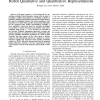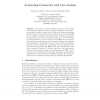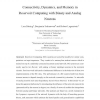313 search results - page 60 / 63 » Lazy Abstraction with Interpolants |
TASLP
2008
13 years 7 months ago
2008
Abstract--Motivated by potential applications in second-language pedagogy, we present a novel approach to using articulatory information to improve automatic detection of typical p...
TFS
2008
13 years 7 months ago
2008
Abstract-- This paper proposes a novel framework for describing articulated robot kinematics motion with the goal of providing a unified representation by combining symbolic or qua...
ICFEM
2010
Springer
13 years 6 months ago
2010
Springer
Abstract. Coinduction is a major technique employed to prove behavioral properties of systems, such as behavioral equivalence. Its automation is highly desirable, despite the fact ...
MIG
2010
Springer
13 years 6 months ago
2010
Springer
Abstract. Motion blending is a popular motion synthesis technique which interpolates similar motion examples according to blending weighs parameterizing high-level characteristics ...
NECO
2010
13 years 6 months ago
2010
Abstract: Reservoir Computing (RC) systems are powerful models for online computations on input sequences. They consist of a memoryless readout neuron which is trained on top of a ...



